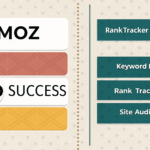
In the vast field of SEO, certain metric can be the deciding factor between a site that soaring through the ranks and one that is an undiscovered gem. The Moz Spam Score is one such measure, yet its intricate details may be difficult to grasp for even the most knowledgeable writers. This guide is designed for content creators looking to understand the importance of Spam Score.
What is Spam Score?
Spam Score is a measurement that was developed by Moz which measures the degree of chance of being penalized by search engines because of the profile of a website’s backlink. What do these mean for you, the committed blogger? This is a warning system. If you have a high Spam Score can suggest Google is less inclined to believe in the links on your website which could hurt SEO efforts and ultimately your search engine rankings.
How to Interpret and Utilize Spam Score in Practice
Let us unravel the intricacies and give you an outline of how to navigate this Spam Score terrain effectively. In the beginning, we’ll examine the causes of an excessive Spam Score, and offer concrete tips on how to handle the issue.
Demystifying the Numbers
A low score for spam (0-2) Low Spam Score (0-2) is considered to be the green zone. Moderate Spam score (3-7) Afraid of Orange. There’s room to improve, however, you’re not quite there just yet.
The High Score (8-17) Red alert. It doesn’t mean you’re destined to fail but it’s a major signal to get your house cleaned.
Here are the most common factors that can cause your Spam Score up
Backlinks of low quality: Links from suspicious websites or link farms won’t bring your Spam Do you any favors.
Over-optimization A lot of anchor texts that contain exact-match keywords could be an indication of red flags.
Links velocity An abrupt rise in backlinks is suspect, especially in the case of poor quality sources.
Lowering Your Spam Score
To reduce the high Spam Rating, you’ll have to work hard in Your backlink’s information profile. Here’s how to do it:
Review your backlinks Utilize tools to periodically check the quality of sites that link to you.
Disavow links that are harmful: For those websites that you cannot get rid of, disavowing them via the Google Search Console can be the alternative.
Create high-quality hyperlinks: Focus on building links on reputable websites that have high editorial standards. Quantity over quality is the gold rule in this case.
The Long-Term Strategy for Managing Spam Score: SEO isn’t a race; it’s an endurance race. The same goes for the way you approach Spam Score should be a element of your long-term strategy for content. Always monitor your backlinks make high-quality content that will attract organic links and be aware of the latest best practices in the industry.
Always Audit, Always Evolve
Regularly reviewing your backlink profile ought to be as regular as going through the spam file. Do not overlook this important step since the web is constantly changing, as will your landscape of backlinks.
Networking for Links
Establishing relationships with people in your field can result in quality, natural backlinks. This may be through guest posting, including in round-ups or making contact with similar websites.
Quality Content is King
The cliche holds as true. The best method to get quality backlinks is to create content that is shared widely and naturally draws hyperlinks from other websites.
Navigating Your Content Creation and Linking Strategy
Content writers frequently contribute to high Spam scores through ineffective linking methods. Here’s the best way to avoid it.
The Anchor Text Strategy
You can diversify your search by using brand terms and your URL, or other generic terms alongside specific keywords.
Outbound Links Matter
Similar to outbound links, the quality and relevancy of your links outbound influence how you score on your Spam Score. Be sure to link to reliable and trustworthy sources.
Utilizing SEO Tools
Platforms such as Moz, SEMrush, and Ahrefs provide robust backlink analysis tools that include tools to monitor and analyze the Spam Score.
The Disavow Tool
Google Search Console hosts a disavow feature that lets you ask Google to block certain websites. It’s an effective tool to combat high Spam Score.
Link Building Strategies
Keep up-to-date with the latest developments techniques for building links. Participate in webinars, read whitepapers, and keep abreast on SEO-related blogs so that you stay ahead of the latest developments.
Conclusion: Your Toolkit for a Healthy Link Profile
The profile of your link is a clear representation of your website’s credibility for search engines. Knowing and managing your Spam is a vital element of maintaining your link profileas well as, by extension your website’s health and robust. It requires diligence, planning and a constant commitment to high-quality. By adhering to the rules laid out in the article you’ll be better prepared to create an SEO-friendly website profile which will help you with efforts to create quality content.

I am Ray Jones Digital
My current occupations: a Digital Marketer, Local SEO expert, Link Builder, and WordPress SEO specialist. Shopify SEO, Ecommerce Store Management, and HTML & WordPress Developer I have been practicing the above mentioned services for more than 10 years now As an SEO expert working with your ongoing projects.



